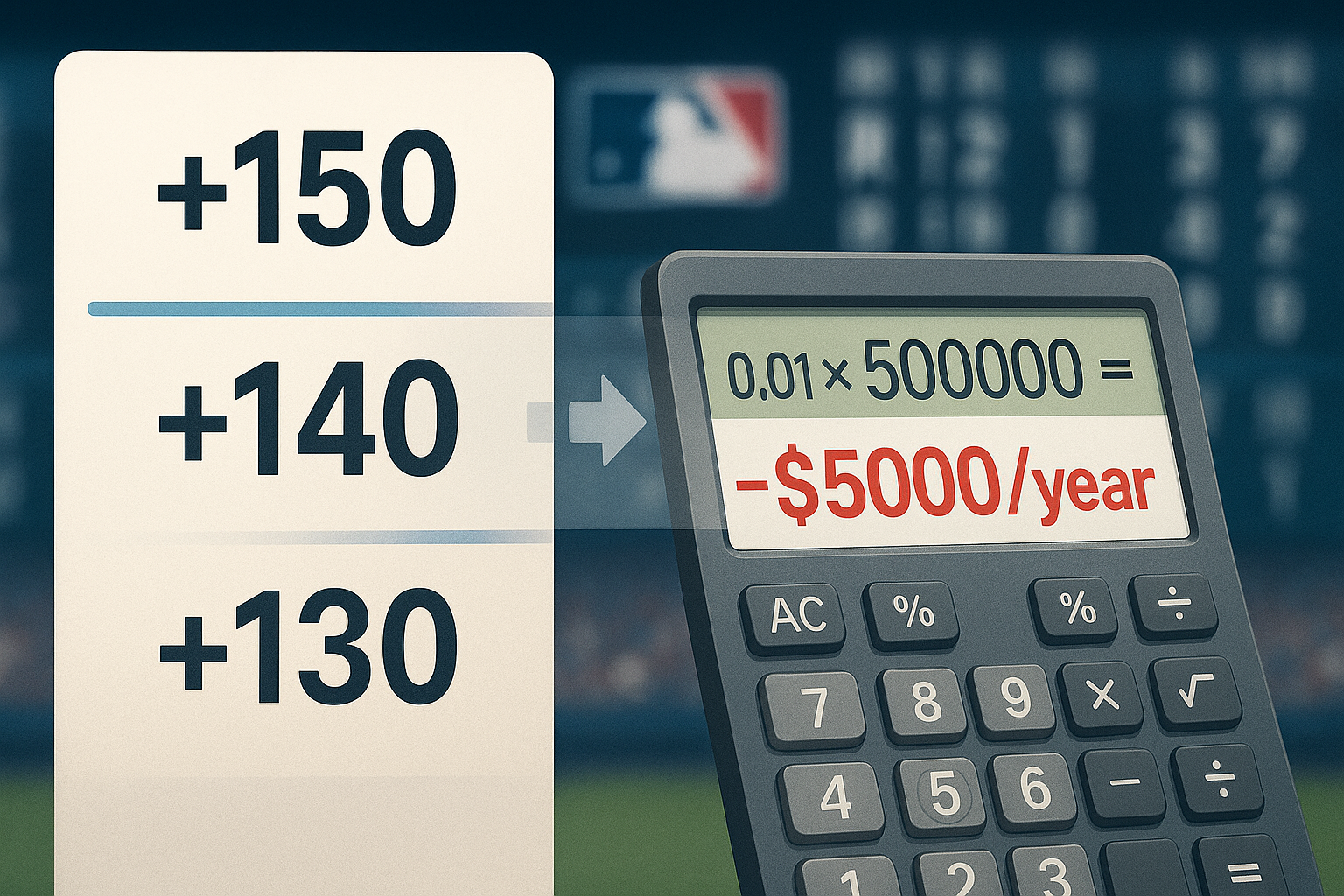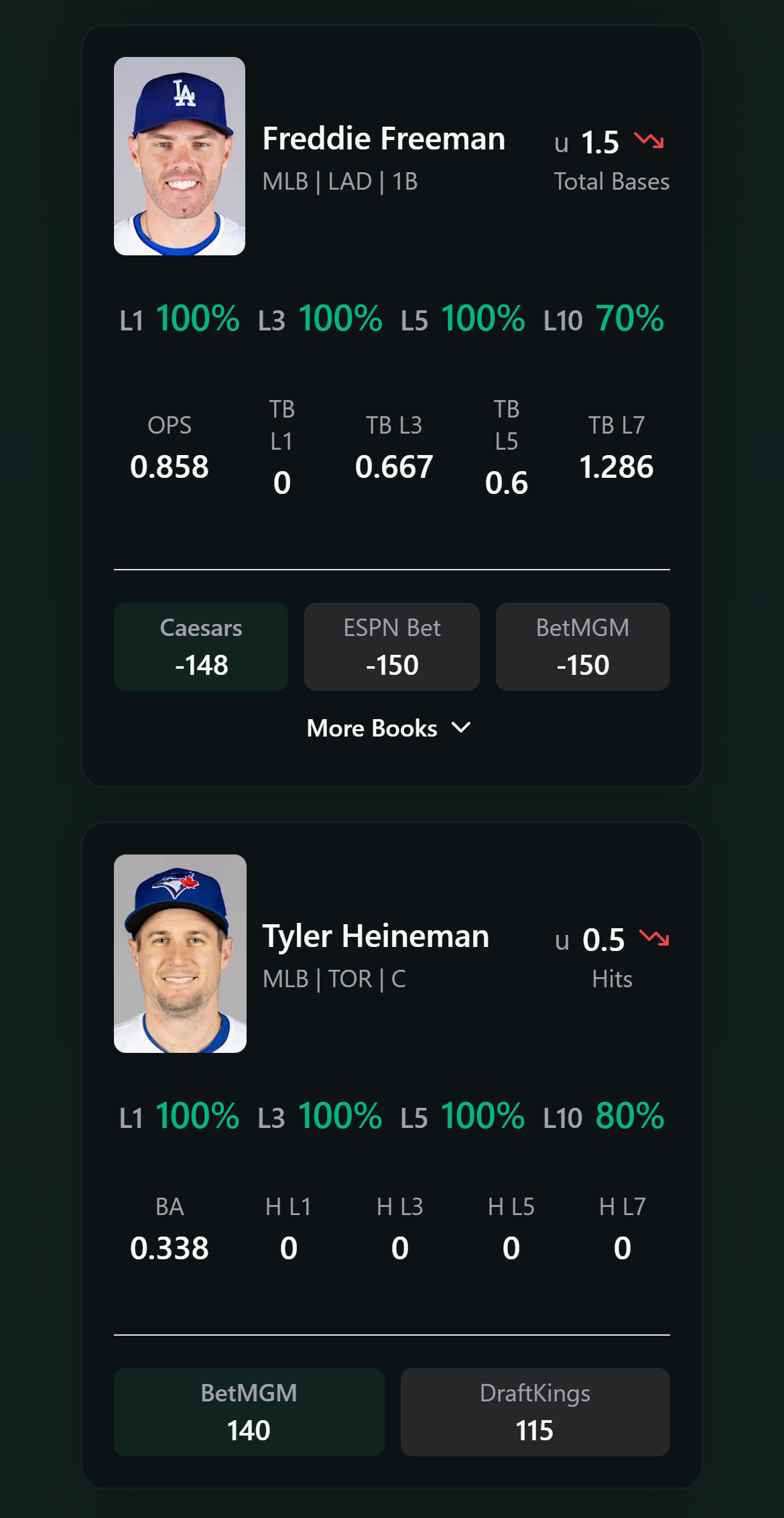Ever notice how the lines you want are always gone by the time you're ready to bet? You're not alone. The most common mistake from amateur bettors isn't picking the wrong teams, it's getting the right teams at the wrong prices.
That -110 that looked juicy last night is suddenly -130 when you wake up. What do you do? Most recreational bettors hold their nose and take the worse number anyway. This seemingly small decision is the invisible killer of bankrolls across the betting landscape.
The Real Cost of Chasing Lines
Let's be brutally honest: chasing lines is a mathematical death sentence for your bankroll. When you consistently bet numbers worse than what was available earlier, you're surrendering your edge before you've even placed a bet.
Here's what this costs in real money:
Imagine you chase MLB moneylines by an average of 10 cents per bet (taking -130 instead of -120, or +140 instead of +150). On a modest $100 bettor making 500 bets per year, that's approximately $5,000 in expected value gone. Not from losing bets, but from taking bad prices on what might otherwise be good picks.
This doesn't even account for the psychological damage of playing from behind. When your expected value (EV) is negative from the start, you're more likely to chase losses, increase bet sizes, or make other bankroll-killing decisions.

Why Lines Move (And Why It Matters)
Lines don't move randomly. They move because of two primary forces: sharp money and public perception.
When professional bettors attack a line they perceive as off, bookmakers adjust quickly. These moves tend to be the most significant early in the betting cycle—overnight or early morning—before casual bettors have even checked the day's odds.
By contrast, public perception moves, which often swing in predictable directions (toward favorites, overs, and popular teams), typically occur closer to game time as recreational money floods in.
The secret that separates pros from amateurs? Timing. The professionals aren't necessarily making substantially different picks. They're getting substantially better prices on those same picks.
Consider Jacob Lopez's recent start against the Tigers. The opening strikeout total was 5.5 (-110). By game time, after an influx of sharp money, it had moved to 6.5 (-120). A recreational bettor taking the under at game time was not only laying more juice but also giving up a full strikeout. The difference in expected value between those two bets was approximately 25%.
Three Concrete Strategies To Beat Line Movement
1. Line Shopping Is Non-Negotiable
If you're betting with a single sportsbook in 2025, you're volunteering to lose money. The variance in MLB lines between books can be substantial, especially in prop markets.
Case in point: Last week, one major book had Spencer Strider's strikeout total at 7.5 (-115), while another had it at 7.5 (-135). Same bet, 20-cent difference in price. These discrepancies add up dramatically over time.
Pro Tip: WagerLens Prop Cards show multiple books that share the same line, often with different prices. Utilize this to your advantage
Action steps:
- Maintain accounts at a minimum of three sportsbooks
- Scan through WagerLens Prop Cards throughout the day
- Prioritize books that are frequently off-market (slow to adjust)

2. Establish a Line-Watching System
Top bettors don't just look at today's lines, they track movement patterns aggressively. This isn't just about finding good prices; it's about understanding what the market is telling you.
For example, MLB totals that open at 8 and quickly move to 8.5 overnight are telling you something fundamentally different than totals that gradually drift up throughout the day. The former often indicates sharp positioning, while the latter may simply reflect public betting patterns.
Action steps:
- Set alerts for overnight line moves in your key markets
- Record opening lines for priority games and track movement
- Pay special attention to reverse line movement (when the line moves against heavy public action)
3. The First Five Innings Edge
One of the sharpest angles in baseball right now is first five innings (F5) betting. This market focuses exclusively on the portion of the game controlled by starting pitchers, eliminating bullpen variability.
What makes F5 betting particularly valuable is that these markets are often priced less efficiently than full-game lines, as they receive less public attention and betting volume. Many books also post these lines later, giving you more time to analyze overnight movement in the main markets before F5 lines are established.
Teams like Houston, San Francisco, and St. Louis have shown consistently strong F5 performances in 2025, often outperforming their full-game results. While the public gets caught up in full-game narratives, sharp bettors capitalize on these starter-specific edges.
Action steps:
- Focus on pitchers with dramatic splits between early-inning and late-inning performance
- Target teams with strong starting rotations but weaker bullpens for F5 bets
- Compare F5 run lines to full-game run lines to identify mispricing
The Pitcher Prop Opportunity
If there's one area where timing and line shopping create massive edges right now, it's in MLB pitcher props: particularly strikeout totals.
These markets have exploded in popularity, but they're still priced less efficiently than core markets. The variance between books can be stunning, with the same pitcher's strikeout total sometimes differing by a full K between sportsbooks.
Take Jacob Lopez as an example. When facing bottom-10 offenses (in terms of strikeout rate), his strikeout totals routinely open too low and close 0.5-1.0 Ks higher. Getting in early on these props—especially against lineups with high whiff rates—has been one of the most profitable patterns of the 2025 season.
What makes pitcher props especially valuable is how straightforward the analysis can be. You don't need complex models—just an understanding of pitcher strikeout rates, opponent strikeout vulnerability, and umpire tendencies. This simplicity allows you to quickly identify edges without getting lost in analysis paralysis.
Implementing Your Anti-Chase System
Here's what a sharp line-management process looks like in practice:
- Evening before games: Review opening lines and make note of potential plays
- Late night/early morning: Check for overnight movements and place bets on significant early shifts that align with your analysis
- Morning: Line shop across all available books for best prices on remaining targets
- Throughout day: Monitor reverse line movement situations where sharp money might be taking positions against public perception
- Pre-game: Consider live betting strategies based on line evolution throughout the day
The key is developing a consistent rhythm that works with your schedule. Even if you can't bet overnight lines due to work or other commitments, simply understanding line movement patterns will make you a sharper bettor.
The Disciplined Approach Pays Off
Consistently getting good closing line value (CLV) is perhaps the single most reliable predictor of long-term betting success. Studies have repeatedly shown that bettors who beat the closing line by even modest margins tend to be profitable over time, regardless of their specific strategies.
This isn't just about being a careful shopper—it's about fundamentally understanding what drives market efficiency and exploiting the windows where that efficiency breaks down.
Remember: The house edge in sports betting isn't built into the games themselves (like in casino games); it's built into the pricing. When you consistently take bad prices, you're essentially creating an insurmountable house edge against yourself.
By contrast, when you consistently beat the closing line—through early action, aggressive line shopping, or identifying inefficient markets like F5 and pitcher props—you're systematically dismantling that edge, bet by bet.
The difference between a winning and losing bettor often isn't about picking winners and losers. It's about consistently finding value in the prices you take.
Stop chasing lines that have already moved. Start putting yourself in position to create your own closing line value. Your bankroll will thank you.
